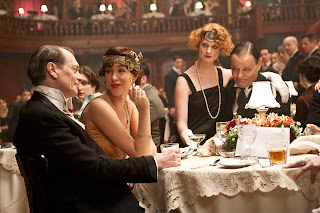Production Designer: Alfred Sole
Set Decorator: Claire Kaufman
Source: IMDB
Confession: I haven’t seen that many episodes of “Castle.” What I do know about the series is that it teams a writer, Castle (Nathan Fillion, who is awesome in everything that he’s in), and a cop, Beckett (Stana Katic, whom I have not seen in anything else, but is enjoyable with her wry sense of humor). Their cases have been known to have a whimsical attitude at best and downright fantastical one at worst, mostly due to Castle’s imaginative brainstorming.
Source: IMDB
Confession: I haven’t seen that many episodes of “Castle.” What I do know about the series is that it teams a writer, Castle (Nathan Fillion, who is awesome in everything that he’s in), and a cop, Beckett (Stana Katic, whom I have not seen in anything else, but is enjoyable with her wry sense of humor). Their cases have been known to have a whimsical attitude at best and downright fantastical one at worst, mostly due to Castle’s imaginative brainstorming.
A number of the set-ups and settings presented in the show contribute to the overall atmosphere. This week’s unusual locale is an underground steampunk* society. “It’s a subculture that embraces the romance and simplicity of the past and at the same time couples it with the hope and promise and the sheer super-coolness of futuristic design,” Castle explains. Apparently this means that their ideal clubhouse should look like a Victoriana version of a TGIFriday’s. With no tables or chairs.
*A genre of science fiction set in Victorian times when steam was the main source of machine power. Source: dictionary.com
 |
| Source: ABC.com |
The scenes shown in the Gaslamp League: Private Steampunk Society headquarters make my brain itch quite a bit. The primary reason for this is that I have no idea what is meant to take place in this clubhouse other than to drink, stand around in packed quarters wearing highly dramatic period clothing, and ride around through the masses in steam-operated pennyfarthings that decimate the air quality. Do they hold meetings at all? Discuss literature? Practice the Virginia Reel? Conduct bake sales?
We know that they like to show off their collections of antique weaponry (a plot point), time machine replicas, glowing Big Ben clocks, and a presentation of the film “A Trip to the Moon” on constant loop. Don’t get me wrong, it’s all very cool stuff. Only this particular set exists only to further the plot in order to partially explain why their victim could die in a turn-of-the-century duel.
 |
| Source: ABC.com |
In design school one of our projects involved creating an interpretive center based solely on one design movement. At first I had thought that maybe have been the direction taken here. Only the inclusive nature of interpretive centers stands in direct contrast to the barrage of trivia questions Castle and Beckett were accosted with upon their arrival.
I feel that the art department was severely limited here with what they could do, and that the situation possibly was based on time, budget, and/or producer/director input. In response, the fantastic individual pieces were unable to create a cohesive whole. Perhaps this is the nature of temporary sets? Leave your thoughts below!
P.S. If you waited around during my tech issue drama, thanks and welcome back!












